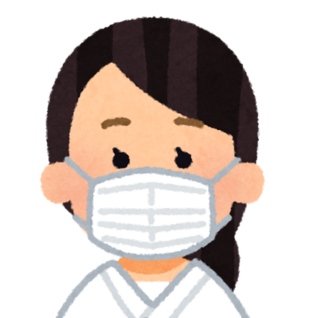Hi there ! I’m Mao who works for Home Nursing Station.
Even if you study hard at the university, I think you forgot about it when you start working as Nurse.
I studied all night for the national exam, but I’m still wondering what is the phenomenon of forgetting everything as soon as the exam is over ?
For such nurses, I will explain the “Physical Assessment” that can be used in Home Nursing with actual examples.
What’s Physical Assessment ?

“Physical assessment” literally means “evaluating the patient’s body”.
For the physical assessment, the nurse integrates information based on subjective judgments with direct patient complaints such as “pain” and “baffling,” and information from objective data obtained from the results of vital checks, etc.
・Subjective Information: Patient’s complaint etc.
・Objective Information: Data obtained from vital check.
The nurse has to comprehensively judge the patient’s condition from both “Subjective” and “Objective” viewpoints.
Just Feel “Different From Usual” for Physical Assessment
The important thing in physical assessment is to feel sensitively the patient’s “different from usual” and “something strange”.
In Home Nursing, the nurse in charge is the one who knows the patients the most because you frequently go to the patients to provide care.
When interacting with patients on a daily basis, if you feel that “this day is different from usual,” always remember to return to the basics of physical assessment.
The nurse is professional with eyes which can carefully find “different” from the patients.
Physical Assessment Should Start From Least Burden On Patient
A physical assessment is required for each patient one by one.
For this purpose, there are the order from “Interview”, “Visual Inspection”, “Palpation”, “Percussion”, and “Auscultation”. It is important to carry out them in order of least burden on the patient.
The basic flow is as follows.
1, Interview: Ask and listen directly to the patient and family.
2, Inspection: Visually check the condition of the body.
3, Palpation: Check by touching the body.
4, Percussion: Tap a part of the body lightly to confirm.
5, Auscultation: Check the internal state of the body by sound.
Of course it depends on the patient’s condition, but if the basic procedures are followed, the burden on the patient will be less.
This procedure will usually be taken at patient’s home, remember “Patient First”.
Case Study Of Physical Assessment

I have explained that physical assessment is subjectively and objectively judged.
I also will explain how to use it in your workplace with examples.
the patients who appear here have been slightly edited based on cases I’ve heard from my colleagues.
Please understand even if the symptoms are the same as the examples in this physical assessment, it does not necessarily mean that the same treatment is necessary.
Each time, do a correct physical assessment and treatment, and if you feel even a little uneasy, talk to your seniors or superiors.
Case 1, Physical Assessment
In the physical assessment example 1, we will look at “what the nurse thinks” and “what the nurse did” for the following patient.

[Patient A]
Age: Female in her 80s
Residence: Living alone
Current: Chronic heart failure
Pre-existing condition: sepsis
Status: Appetite is normal during urethral catheterization
One day, the helper received a call from patient A and call the Home Nursing Station that she suddenly had a fever of 37.6°C and vomited after eating.
According to the helper, patient A seems to have calmed down after vomiting, but the fever still did not go down. The helper asked us if patient A could wait and see with this situation.
According to patient A, her physical condition is not so bad, but she wanted a nurse to come just in case, so the nurse in charge visited her.
・Patient A is lying in the bed.

【What the Nurse thinks】
・Even patient A is usually quiet. But she asked us “Come to me.”.
・Is A still feeling bad instead of good complexion on her ?

【What the Nurse did】
・Virtual Inspection: Her complexion is getting to become red seeming like breathing problem.
・Interview: Asked “Is it painful ?”, but answered “No.”.

【What the Nurse thinks】
・I still can’t judge whether the reason patient A says “it’s not painful”, because of possibility that she dulls the sense.
・Wondering she is sitting because lying down is extra painful ?
・She may have respiratory or circulatory problems.

【What the Nurse did】
・Measure the pulse: The pulse is quite fast, around 120 beats / min.

【What the Nurse thinks】
・Fortunately, there is no irregularity in the pulse, so hemodynamics is in the normal.
・However patient A has had the sepsis in the past and may have *Warm Shock as far as flushing and sweating.
・Her sudden drop in blood pressure could lead to loss of consciousness.

Warm Shock is explained link below.
『National Library of Medicine』

【What the Nurse did】
・Measured SpO2: 89%
・Measured Respiration: 30 times/min

【What the Nurse thinks】
・Since her breathing is fast, so trying to take in oxygen, but she is not able to take in enough oxygen, which puts a strain on heart.

【What the Nurse did】
・Confirm urine volume: 800 mL/10 hours
・Check urine properties: dark and cloud

【What the Nurse thinks】
・Patient A is taking a diuretic for chronic heart failure, but she has a small amount of urine today.
・She may have a urinary tract infection due to cloudy urine.

【What the Nurse did】
・Auscultate breath sounds: no adventitious noises

【What the Nurse thinks】
・Possibility of respiratory infection is considered to be low.
・Instead of that increased risk of urinary tract infection.

【What the Nurse did】
・Palpate the back and waist: No pain

【What the Nurse thinks】
・It does not seem to reach the kidneys.

【What the Nurse did】
・Measured blood pressure and body temperature: Blood pressure 110/60mmHg, body temperature 37.6℃
・Blood pressure is slightly low, but hemodynamics is in normal now.
・The fever isn’t appeared so much, but if patient A has a urinary tract infection, fever could expect appearing up even more.
・An intravenous drip of antibiotics can be given here, but I am worried that there is no family or relatives who can closely watch her over because of living alone.
・ Considering the burden on the heart, l suggested her and called an ambulance.
Based on the results of the above physical assessment, I told the patient that it would be difficult to treat at home and suggested that she go to the hospital.
It was a proposal that respected patient A intentions and followed her wishes, but she seemed to be satisfied by my proposal, so I contacted the doctor and called an ambulance.
After then, as a result of the examination at the hospital, it was found that patient A had worsened sepsis and chronic heart failure due to urinary tract infection, and she was is hospital for about 3 weeks for a treatment.
Case 2, Physical Assessment
In the physical assessment example 2, let’s look at “what the nurse thinks” and “what the nurse did” for the following patient.

[Patient B]
Age: Male in her 80s
Residence: Living with wife
Current: Asthma, hypertension, Alzheimer’s dementia
Status: Able to go out alone in the neighborhood
The patient B’s daughter lived in the neighborhood, and she often comes to see how he was doing every day after her work.
One day, when she was talking to patient B, she noticed that he had phlegm and was making a wheezing sound. She called Home Nursing Station.
According to patient B, he has no particular problem, but the nurse in charge went to him because he became worried.
・He doesn’t look like it’s in pain at all, and it’s moving around here and there.
・There is no problem with the complexion, and it looks like the usual patient B.
・As his daughter said, there is a whooshing sound coming from his throat.

【What the Nurse thinks】
・Respiratory symptoms appear, but seems oxygen is sufficiently supplied from seeing how he moves around.

【What the Nurse did】
・Measured SpO2: 95%
・Measured respiration: 15 times/min

【What the Nurse thinks】
・From the results of SpO2, there is no problem with the amount of oxygen so far.

【What the Nurse did】
・Measured body temperature: 35.6℃ (normal)
・Measured pules: 100 times/min (normal)
・Measure blood pressure: blood pressure 125/77mmHg (slightly high, but not different from usual)

【What the Nurse thinks】
・Although phlegm entanglement and breathing changes occur frequently, it is thought that there is no effect on the whole body.
・Wondering what part of the lung is causing this symptom ?

【What the Nurse did】
・Listening to breath sounds: Confirmed that there was a low-tone continuous accessory murmur in the upper left lobe.
・There is secretion in the upper left lobe, but it is hypotonic and unlikely to block the airway.
・It would be okay to have patient B take the bronchodilator that is being prescribed and see how he goes.
・Asked daughter to observe him more carefully than usual.
After the few days, I got a call from patient B’s daughter, and I received a report that he didn’t seem to have changed and was able to eat well.
The nurse felt thanks to the family who supported patient B, the most important thing is that everyone can live with peace of mind.
Conclusion

As in the two examples introduced this time, it is important to understand the patient’s condition from both “Subjective information” and “Objective information” in physical assessment.
In addition, since information from the patient’s family is also a very valuable source, it is important to listen carefully to not only the patient’s talk but also the family’s talk when visiting them.
I hope that you will make use of the physical assessment in the field of Home Nursing and strive to acquire your own skills.




